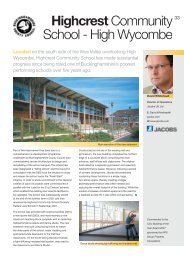A Guide to Standard forms of Construction Contract - Public ...
A Guide to Standard forms of Construction Contract - Public ...
A Guide to Standard forms of Construction Contract - Public ...
You also want an ePaper? Increase the reach of your titles
YUMPU automatically turns print PDFs into web optimized ePapers that Google loves.
JCT: IFC<br />
Intermediate Form <strong>of</strong> Building <strong>Contract</strong><br />
JCT: MW 98<br />
Agreement for minor work<br />
SELECTION<br />
CRITERIA<br />
Client involvement<br />
Design/management<br />
separation<br />
Capacity for variations<br />
Complexity<br />
Speed<br />
Cost certainty<br />
Clarity <strong>of</strong> remedies<br />
Default<br />
Delay<br />
Quality failure<br />
RISK AREAS<br />
SELECTION<br />
CRITERIA<br />
Client involvement<br />
Design/management<br />
separation<br />
Capacity for variations<br />
Complexity<br />
Speed<br />
Cost certainty<br />
Clarity <strong>of</strong> remedies<br />
Default<br />
Delay<br />
Quality failure<br />
RISK AREAS<br />
LOW<br />
EMPLOYER<br />
LOW<br />
EMPLOYER<br />
HIGH<br />
CONTRACTOR<br />
HIGH<br />
CONTRACTOR<br />
This general contract form is published with the following associated documents:<br />
• IFC/FS Fluctuations supplement and formula rules.<br />
• IFC/SCS Sectional completion supplement.<br />
• NAM/T 98 Tender and agreement for named sub – contrac<strong>to</strong>rs.<br />
• NAM/SC 98 sub – contract conditions for named sub – contrac<strong>to</strong>rs.<br />
• ESA/1 RIBA/CASEC Employer/Specialist agreement.<br />
• IN/SC Articles <strong>of</strong> agreement for domestic sub – contracts.(cic)<br />
• IN/SC Conditions for domestic sub – <strong>Contract</strong>s.(cic)<br />
This form is published with a single associated document, the Minor Works<br />
supplement, which covers contributions, levy and tax changes and statu<strong>to</strong>ry deduction.<br />
notes<br />
This contract is designed for use only on small and simple works. The conditions give a bare outline<br />
<strong>of</strong> the parties’ duties and responsibilities, and risk allocation is <strong>to</strong>o simple for more complex<br />
situations. It is very useful for such projects domestic extensions, but generally should not be used<br />
on contracts exceeding £70,000 (at 1992 prices). Its principal feature is simplicity, but this is a<br />
disbenefit when exposed <strong>to</strong> many different kinds <strong>of</strong> risk.<br />
notes<br />
Bridges the gap between JCT 98 and MW 98, this is a fairly complex form. Intended for well<br />
specified traditional building work without complex services packages. For specialist work it utilises<br />
“naming” rather than “nomination”. It is flexible and can be used with or without bills <strong>of</strong> quantities.<br />
6<br />
7
















